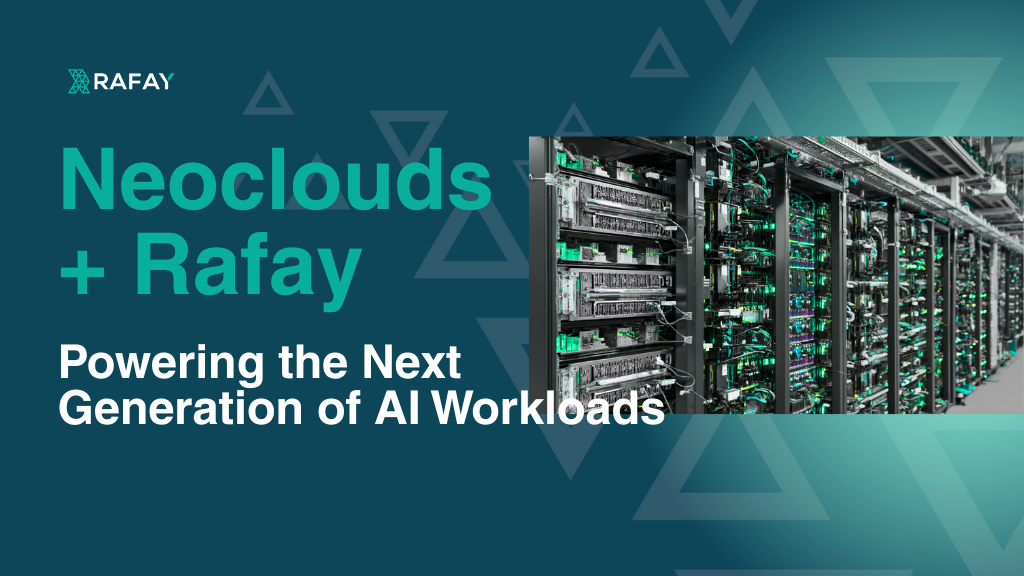Neocloud Providers: Powering the Next Generation of AI Workloads
Artificial intelligence teams face critical challenges today: Limited GPU availability, orchestration complexity, and escalating costs threaten to slow AI innovation.
Read Now
Generative AI has revolutionized what’s achievable in modern enterprises—from large language models (LLMs) powering virtual assistants to diffusion models automating complex image generation workflows. However, behind this wave of innovation lies a significant infrastructure challenge: the escalating cost and complexity of running generative AI workloads at scale. For platform engineering teams tasked with delivering reliable, performant environments while adopting AI initiatives, managing the true cost of AI infrastructure has never been more critical.
This post explores the hidden costs embedded in generative AI workloads, why traditional infrastructure management strategies fall short, and how Rafay’s infrastructure orchestration layer, that enables GPU PaaS (Platform-as-a-Service,) provides a scalable, cost-optimized foundation tailored specifically for generative AI applications, addressing security challenges, data privacy, and ethical considerations.
Ready to reduce the cost of running GenAI? See how Rafay helps
Generative AI workloads encompass the computational tasks involved in training, fine-tuning, and serving artificial intelligence models that autonomously generate new content—whether text, images, code, or audio. These workloads include:
Unlike traditional machine learning tasks, generative AI workloads demand:
These factors contribute to generative AI’s reputation as extremely resource-intensive, especially when deployed at scale across multiple environments.
While most teams anticipate high compute costs, several hidden expenses often go overlooked:
1. GPU Overprovisioning: To guarantee availability, teams frequently over-allocate GPUs, resulting in underutilized resources and inflated cloud bills.
2. Idle Infrastructure: Without intelligent workload placement and autoscaling, GPUs remain idle between model training or inference runs, wasting budget without delivering value.
3. Network and Data Egress: Transferring large amounts of training data, model checkpoints, and inference results between clusters, clouds, or storage systems incurs significant costs—especially in hybrid or multi-cloud setups.
4. Lack of Observability: Without real-time insights into workload behavior and resource utilization, teams cannot identify inefficient jobs or optimize resource allocation effectively.
5. Operational Complexity: Provisioning, securing, and managing AI workloads across Kubernetes clusters and cloud environments demands skilled personnel, manual effort, and constant coordination, increasing overhead.
Cost escalation is often hidden in the details of infrastructure management. Key areas where spend can quietly spiral include:
The key to controlling costs lies in visibility and governance. Without a centralized control plane, diagnosing inefficiencies or enforcing cost controls is difficult, leading to runaway expenses.
Platform engineering introduces a transformative approach: delivering standardized, reusable infrastructure as a service for internal teams. This paradigm enables:
For generative AI workloads, platform engineering abstracts away infrastructure complexity, enabling teams to concentrate on developing and deploying AI models efficiently and securely, while addressing several challenges like bias, data privacy, and security challenges inherent in AI solutions.
Rafay provides an infrastructure orchestration layer that enables enterprises and cloud providers to deploy a GPU Platform-as-a-Service (PaaS), which is purpose-built to simplify how organizations build, deploy, and scale generative AI workloads. Key features include:
Centralized GPU Management: Provision, monitor, and scale GPU clusters from a single pane of glass, across on-premises, cloud, and hybrid environments.
Multi-Environment Support: Seamlessly manage AI infrastructure across diverse environments without operational overhead or fragmentation.
Dynamic Scaling: Automatically allocate GPU resources based on real-time workload demand, minimizing idle compute and reducing costs.
Policy-Based Governance: Enforce GPU limits, job prioritization, and access controls by team or project, ensuring efficient resource utilization and security compliance.
Observability & Insights: Real-time dashboards provide detailed metrics on GPU utilization, workload efficiency, and cost impact, enabling data-driven decision making and better resource allocation.
By leveraging Rafay’s infrastructure orchestration platform, AI/ML teams gain full control over generative AI workloads, optimizing resource allocation and reducing infrastructure complexity without reinventing the wheel or incurring runaway costs.
1. LLM Training Pipelines: Rafay dynamically provisions GPU clusters for large-scale model training and fine-tuning across regions, then deprovisions resources post-training to eliminate idle costs.
2. GenAI Inference Services: Run cost-aware inference pipelines by allocating GPU-accelerated nodes only to latency-sensitive workloads, while routing less critical tasks to CPU resources.
3. Internal AI Portals: Enable data scientists and ML engineers to deploy and manage AI models via self-service interfaces, while maintaining centralized control, observability, and governance.
Generative AI is pushing the boundaries of what organizations can achieve—and what their infrastructure must support. The cost of running LLMs, diffusion models, and other AI workloads extends beyond cloud bills to include idle compute, fragmented environments, and operational complexity.
Rafay’s infrastructure orchestration layer that enables a GPU PaaS provides a smarter foundation for generative AI, enabling organizations to accelerate time to value, reduce infrastructure spend, and simplify operational management. By centralizing control, automating resource allocation, and delivering real-time visibility, Rafay empowers platform teams to optimize generative AI workloads at scale with confidence and efficiency, overcoming several challenges and unlocking potential benefits across many industries.
Generative AI workloads involve training or serving models that create new content, such as text, images, or code. These workloads demand significant computational power and specialized hardware to operate efficiently.
Running generative AI workloads requires high-performance GPUs and large data volumes, which drive up compute and operational costs. Managing these workloads across multiple environments adds further complexity and expense.
Rafay’s infrastructure orchestration layer enables organizations to deploy a GPU Platform-as-a-Service (PaaS), which simplifies GPU infrastructure management by automating provisioning, scaling, and monitoring. This platform helps teams efficiently run generative AI workloads without the usual operational overhead.
Yes, Rafay optimizes resource allocation by automating scaling and providing real-time visibility into GPU usage and costs. This reduces waste and lowers the total cost of ownership for AI infrastructure.
Visit rafay.co to learn more or book a demo to see how Rafay’s platform can streamline your generative AI workload management and cut infrastructure costs.

Artificial intelligence teams face critical challenges today: Limited GPU availability, orchestration complexity, and escalating costs threaten to slow AI innovation.
Read Now

Generative AI has revolutionized what’s achievable in modern enterprises—from large language models (LLMs) powering virtual assistants to diffusion models automating complex image generation workflows.
Read Now